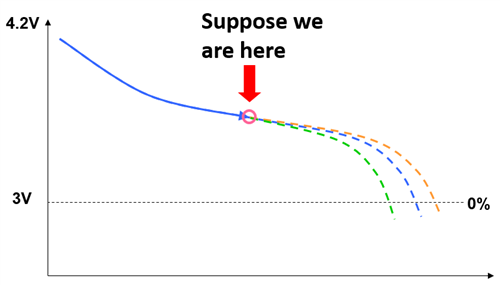When you hear the term “gas gauge,” the first thought that comes to mind might be the gauge in your car. You depend on the accuracy of that gauge to keep you from getting stuck on the side of the road. Likewise, for your portable electronic devices, you depend on the accuracy of your battery’s “gas gauge.”
Figure 1: Gauge predicts how much capacity is remaining.
Gauging a battery is more difficult than gauging a tank of gasoline. You refill the gas tank with new fuel that is essentially the same quality as the previous tank of fuel. This will ensure approximately the same performance from refill to refill. But batteries degrade from charge to charge; thus, you must compensate for this loss of capacity in order to accurately predict when the battery will be empty.
A good gauge can provide state-of-charge (SOC) accuracy within 5%, whereas a best in-class gauge provides 1% accuracy over a wide range of operating conditions and with a minimal set of limitations. Compensated End-of-Discharge (CEDV) type gauges provide good to very good accuracy, but they require full discharge cycles to update the capacity as the battery degrades. This gauge accumulates the amount of charge transferred during the discharge and uses that capacity for the next cycle.
TI gauge integrated circuits with Impedance Track™ battery technology provide better accuracy because they update the two main components of the battery that degrade: the chemical capacity (Qmax) and the series resistance (Ra table). These gauges have special algorithms that use this data – along with the voltage, load current and temperature – to predict the capacity remaining in the pack. Gauge circuits adjust capacity estimates to almost real time to reduce the error in the SOC estimate. In addition, they require only a partial charge or discharge to update Qmax and the Ra table Impedance Track gauges require rest periods, after charge and discharge cycles, to allow the cell voltages to stabilize to set Depth-of-Discharge (DOD) points. The DOD points are used in the Qmax calculation.
Eliminating the need for rest periods will allow learning updates without requiring the pack to set idle for cell voltages to stabilize. FAST_QMAX is a new feature that allows Qmax to update at the end of discharging without a rest period. The bq40z50-R1 offers this feature, while also allowing Qmax updates at the end of charging without a rest period.
The device offers other new features to smooth the SOC profile and accelerate capacity simulations and thus decrease errors near the end of discharging, where cell voltages change more quickly. In addition to enhanced gauging features, the bq40z50-R1 packs new protection features, new control options and a higher-performance measurement system into a smaller-footprint leadless package.
Additional resources:
- Start designing today with the 1 Series, 2 Series, 3 Series, and 4 Series Li-Ion Battery Pack Manager Evaluation Module


